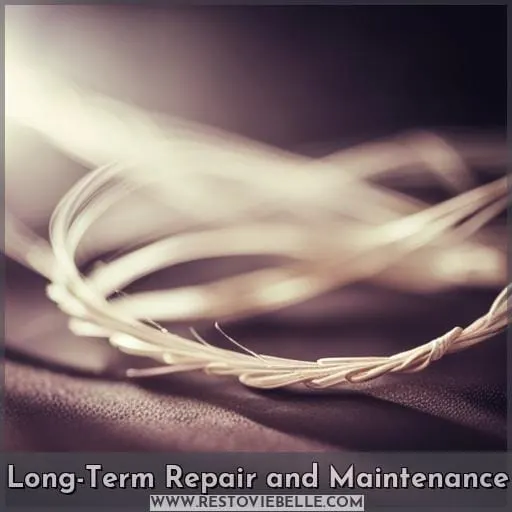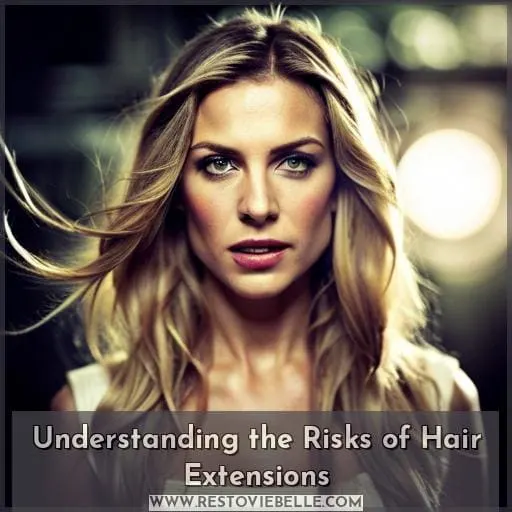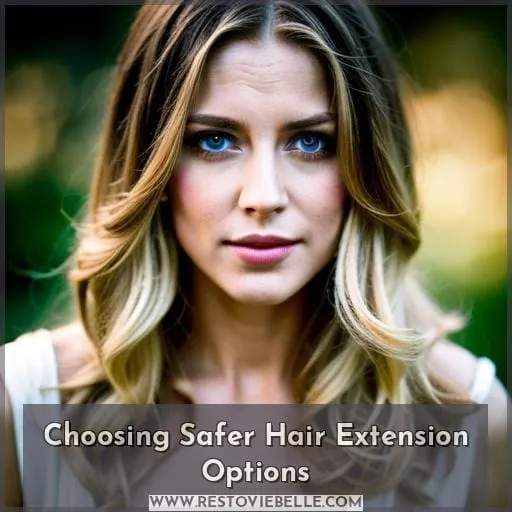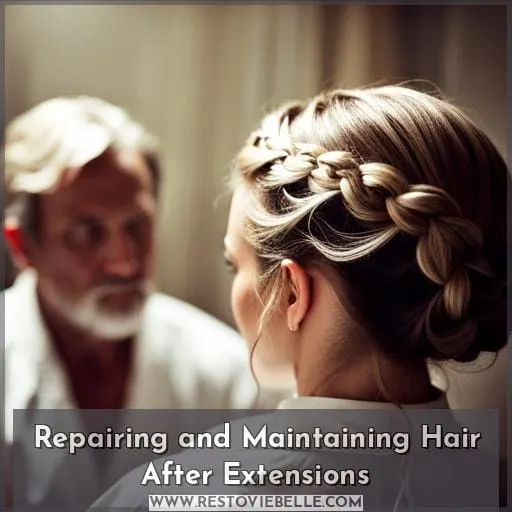This site is supported by our readers. We may earn a commission, at no cost to you, if you purchase through links.
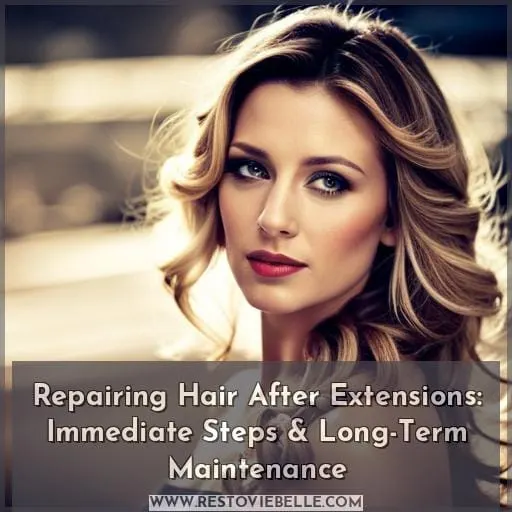 Ready to repair your hair after extensions? Whether you’ve experienced breakage, thinning, or other damage, this article will guide you through immediate steps and long-term maintenance strategies.
Ready to repair your hair after extensions? Whether you’ve experienced breakage, thinning, or other damage, this article will guide you through immediate steps and long-term maintenance strategies.
Discover effective hair treatments, tips for avoiding heat styling, and proper brushing techniques.
Explore the benefits of using sunscreen for hair protection and taking growth supplements.
Learn about safer extension options and how to make informed decisions for the future of your hair.
Say goodbye to damaged locks as you regain control over your beautiful mane!
Table Of Contents
- Key Takeaways
- Damage Control: Immediate Steps
- Long-Term Repair and Maintenance
- Understanding the Risks of Hair Extensions
- Choosing Safer Hair Extension Options
- Considering the Future of Your Hair
- Repairing and Maintaining Hair After Extensions
- Frequently Asked Questions (FAQs)
- Can I dye my hair after removing extensions?
- How long does it take for hair to recover after removing extensions?
- Are there any specific hairstyles I should avoid after removing extensions?
- Can I use hot tools on my hair immediately after removing extensions?
- Is it necessary to trim my hair after removing extensions to promote healthy growth?
- Conclusion
Key Takeaways
- Weekly use of treatments like Olaplex for repair
- Avoidance of heat styling tools to prevent further damage
- Gentle detangling methods to prevent breakage
- Seeking professional advice when encountering persistent issues
Damage Control: Immediate Steps
Now that you’ve removed your hair extensions, it’s time to take immediate steps to repair and restore your damaged hair.
Start by incorporating weekly treatments like Olaplex into your routine, as they help repair broken bonds and reseal the structure of your hair.
Avoid using heat styling tools for now to prevent further damage, and opt for heatless styling techniques instead.
Lastly, make sure you’re regularly brushing your hair with a gentle brush to prevent tangles and knots.
Hair Treatments for Repair
To begin repairing your hair after extensions, start by incorporating weekly treatments into your routine for immediate damage control.
- Weekly treatments such as Olaplex can help repair broken bonds and reseal the hair structure, promoting recovery.
Additionally, avoid heat styling to prevent further damage and opt for heatless styling techniques instead.
- Proper brushing techniques with a gentle detangling brush will also help prevent tangles and knots.
Finally, consider using sunscreen protection on your hair to shield it from harmful UV rays while providing hydration.
Avoiding Heat Styling
To minimize further damage to your hair after removing extensions, avoid using heat styling tools.
Heat can exacerbate the existing damage and weaken your hair even more.
Instead, opt for heat-free styling techniques such as air-drying or braiding your hair into protective hairstyles.
Additionally, incorporate scalp massages and hydration techniques into your routine to promote healthy hair growth and prevent further breakage.
Consider using DIY hair masks to nourish and repair damaged strands without subjecting them to additional heat stress.
Proper Brushing Techniques
Brush your hair gently and regularly to prevent tangles and knots.
Use the following brushing techniques for knot prevention and maintaining a healthy scalp:
- Start from the ends: Begin by brushing the ends of your hair, gradually working your way up towards the roots to avoid pulling on knots.
- Use a wide-toothed comb or detangling brush: These tools are designed to glide through tangled hair without causing damage or breakage.
- Be patient: Take your time when detangling, especially if you have thin or fragile hair. Rushing can lead to more tangles and potential damage.
By incorporating these gentle detangling methods into your maintenance routine, you can effectively care for both natural hair and extensions while promoting overall healthiness in thinning strands after extension removals.
Long-Term Repair and Maintenance
To ensure long-term repair and maintenance of your hair after extensions, there are several key practices to incorporate into your routine.
First, consider using sunscreen specifically formulated for hair protection to prevent dehydration and breakage caused by UV rays.
Additionally, taking hair growth supplements that contain essential nutrients like biotin can stimulate growth and support overall health.
Sleeping on a silk pillowcase reduces friction, preventing frizz and split ends while you rest.
Including beans and lentils in your diet provides comprehensive support for healthy hair growth.
Lastly, if you experience any persistent issues with your hair post-extensions, it’s always wise to consult a dermatologist who specializes in treating such concerns.
Using Sunscreen for Hair Protection
Now, let’s talk about how you can protect your hair from the damaging effects of UV rays by using sunscreen.
Applying sunscreen to your hair is an essential step in maintaining its health and vitality. Look for products specifically designed for sun protection, and apply them generously before heading outside.
This simple yet effective measure will shield your hair from harmful sunrays, preventing damage and keeping it healthy in the long run.
Don’t forget to also consider other protective measures like sleeping on a silk pillowcase and using reputable salon-grade hair products for optimal results.
Taking Hair Growth Supplements
Start supplementing your hair growth journey with the right vitamins and minerals.
Hair growth supplements can be effective in promoting healthy hair growth and repairing damage caused by extensions.
Consultation with a healthcare professional is important to determine the best supplements for your specific needs.
Additionally, incorporating nutrient-rich foods into your diet can have a positive impact on overall hair health.
Take control of your hair’s future by investing in long-term repair and maintenance through proper supplementation and dietary choices.
Sleeping on a Silk Pillowcase
To promote long-term repair and maintenance of your hair after extensions, consider sleeping on a silk pillowcase. By using a silk pillowcase, you can minimize friction and prevent frizz and split ends during sleep.
Sleeping on a silk pillowcase has many benefits for your hair:
- It improves sleep quality by providing a luxurious texture.
- It helps maintain the integrity of semi-permanent extensions.
- It enhances the effectiveness of Olaplex products in repairing damaged hair.
Including Beans and Lentils in Diet
To support long-term repair and maintenance of your hair after extensions, incorporate beans and lentils into your diet for comprehensive nourishment.
Beans and lentils are rich in essential nutrients like protein, iron, zinc, and biotin that promote healthy hair growth.
Their plant-based nutrition provides a nutrient boost to strengthen your hair from within.
Including these legumes in your culinary choices can contribute to improved overall hair health over time.
Consulting a Dermatologist for Hair Issues
If you’re experiencing persistent hair issues, such as traction alopecia or other concerns related to your extensions, it’s important to consult a dermatologist for long-term repair and maintenance.
A dermatologist can provide expert hair advice and offer medical hair solutions tailored to your specific needs. They understand the skin health connection and can recommend holistic hair care approaches that address underlying causes of damage.
Consulting a dermatologist is essential for:
- Regrown hairs
- Managing any complications
- Addressing insecurities about your hair
- Ensuring optimal long-term results
Understanding the Risks of Hair Extensions
When it comes to hair extensions, understanding the risks is crucial.
The weight and strain they add to your natural hair follicles can lead to traction alopecia, a form of hair loss caused by prolonged tension.
Improper application by non-specialists or using extensions on thin or damaged hair can also result in significant damage.
Weight and Strain on Hair Follicles
Experiencing the weight and strain of hair extensions can significantly impact the health of your hair follicles.
The extension’s weight puts pressure on your roots, leading to potential damage like traction alopecia.
It’s crucial to understand these risks before opting for extensions.
However, immediate repair measures such as using hair treatments and avoiding heat styling can help mitigate damage caused by this extra weight.
Long-term care involves protective measures like sunscreen for hair protection and nutritional support through supplements and a balanced diet rich in key nutrients.
Potential for Traction Alopecia
Be aware of the potential for traction alopecia when wearing hair extensions.
Traction alopecia is a form of hair loss caused by prolonged tension on the hair follicles.
To prevent this, consider alternative extension options that minimize damage to your natural hair.
Focus on maintaining scalp health and avoid excessive heat styling, which can exacerbate issues.
Research extension reviews and explore styling techniques without heat to protect your locks while still achieving desired looks.
Risks of Improper Application
To avoid potential damage, be aware of the risks associated with improper application of hair extensions.
Improperly applied extensions can lead to a range of issues and consequences for your hair.
The weight and strain from extensions can cause damage to your natural hair follicles, especially if you have thin or fragile hair.
Long-term use without specialist expertise may worsen existing problems like traction alopecia, resulting in long-term consequences.
It’s essential to prioritize proper application and take steps towards preventing damage during the extension process.
Choosing Safer Hair Extension Options
When it comes to choosing safer hair extension options, there are a few factors to consider.
First, decide between temporary and permanent extensions. Temporary options like clip-ins or halos can minimize strain on your natural hair and allow for daily removal, giving your scalp time to recover.
Additionally, if you have thin or fragile hair, opting for safer options such as halos that are secured without adhesives or proper application and removal of clip-ins is crucial in preventing further damage.
Temporary Vs. Permanent Extensions
When considering the risks of hair extensions, it’s important to weigh the benefits and drawbacks of temporary versus permanent options.
Temporary extensions, such as clip-ins or halos, are recommended for minimal strain on your natural hair.
For fragile hair types, safer options like halos that are secured without adhesives should be considered.
Permanent extensions may cause continuous strain and impact extension lifespan as well as regrowth cycles.
Benefits of Daily Removal
If you’re looking for safer options when it comes to hair extensions, daily removal offers several benefits.
- Promotes Scalp Health: Daily removal allows your scalp to breathe and prevents the buildup of oil and sweat that can lead to irritation or infection.
- Protects Hair Follicles: By removing extensions every day, you reduce the risk of strain on your hair follicles, minimizing the chances of traction alopecia or other forms of hair loss.
- Allows for Extension Alternatives: Daily wear opens up possibilities for alternative extension methods like clip-ins or halos that are less damaging than permanent options.
- Minimizes Lifestyle Impact: With daily removal, you have more freedom in terms of styling choices and activities without worrying about long-term commitment or potential damage to your natural hair.
By opting for daily removal instead of permanent extensions, you prioritize maintaining a healthy scalp while still enjoying the benefits and versatility offered by temporary alternatives.
Suitable Options for Fragile Hair
If you have thin or fragile hair, it’s crucial to consider safer options when choosing hair extensions.
Opting for temporary solutions like clip-ins or halos can minimize damage and strain on your delicate strands.
These gentle alternatives allow for easy application and removal without the need for adhesives that may further weaken your hair.
Prioritizing the health of your natural locks while still enjoying extension-enhanced free styles is essential for maintaining overall hair health.
Considering the Future of Your Hair
As you reflect on your journey to repair your hair after extensions, it’s important to consider the future of your hair.
Making informed decisions about the type of extensions you choose and how they’ll affect your regrowth period and overall lifespan of each strand is crucial.
Take the time to research, read reviews, and seek guidance from a trusted stylist who can help guide you towards successful extension use while prioritizing the health and longevity of your natural hair.
Making Informed Decisions
Before committing to hair extensions, it’s crucial to make informed decisions about the future of your hair.
- The type of extension you choose
- Methods for preventing damage
- Safe removal techniques
- Styling options that minimize harm
- Maintaining scalp health
By understanding these aspects and making educated choices based on research and guidance from professionals in the field, you can ensure a successful experience with hair extensions while prioritizing the long-term health of your natural hair.
Regrowth Period and Lifespan of Hair
As you continue your hair repair journey after extensions, it’s important to understand the regrowth period and lifespan of your hair.
Each strand of hair goes through approximately 22 regrowth cycles and can last up to 6 years. However, applying extensions may shorten these regrowth periods and lessen the overall lifespan of your strands.
It’s crucial to consider the impact that extensions have on your natural growth and prioritize maintaining healthy hair health throughout this process.
Importance of Research and Professional Guidance
When considering the future of your hair, it’s essential to regularly conduct research and seek professional guidance for optimal results.
Researching the best practices for repairing and maintaining your hair after extensions will provide you with valuable knowledge to make informed decisions.
Consulting experts in the field can offer personalized advice tailored to your specific needs, ensuring that you take the necessary steps towards restoring and preserving the health of your natural hair.
Repairing and Maintaining Hair After Extensions
To repair and maintain your hair after extensions, it’s important to focus on both immediate damage control and long-term strategies.
Immediate steps include:
- Using repair treatments like Olaplex to restore broken bonds.
- Avoiding heat styling tools that can worsen the damage.
For long-term maintenance, consider protective measures such as:
- Sunscreen for UV protection.
- Silk pillowcases to reduce friction.
Additionally, providing nutritional support through supplements or a balanced diet rich in protein, iron, zinc, and biotin can promote healthier hair growth.
Immediate Damage Control
Now, let’s dive into how you can immediately repair and maintain your hair after removing extensions.
- Start with revitalizing haircare treatments to repair damage.
- Avoid heat styling to promote immediate recovery.
- Use proper brushing techniques to prevent tangles and knots.
- Establish a post-extension care regimen for long-term maintenance.
Long-Term Repair and Maintenance Strategies
To repair and maintain your hair after extensions, you need to implement long-term strategies that promote health and growth.
Focus on hair nutrition by incorporating a balanced diet rich in protein, iron, zinc, and biotin.
Take care of your scalp health through regular cleansing and moisturizing routines.
Consider haircut styles that minimize further damage to your natural hair.
Adopt gentle styling techniques with minimal heat usage.
Be cautious when it comes to frequent or aggressive hair coloring treatments as they can contribute to damage over time.
Frequently Asked Questions (FAQs)
Can I dye my hair after removing extensions?
Yes, you can dye your hair after removing extensions.
However, it’s important to wait a few weeks to allow your natural hair time to recover and regain its strength.
Consult with a professional stylist for the best approach.
How long does it take for hair to recover after removing extensions?
Recovering from hair extensions can take time, but fear not! With proper care and nourishment, your tresses will bounce back in about 3-6 months.
Are there any specific hairstyles I should avoid after removing extensions?
To promote healthy hair growth after removing extensions, it’s advisable to avoid tight hairstyles that place excessive tension on the roots.
Opt for loose braids, buns, or gentle waves to allow your natural hair time to recover and thrive.
Can I use hot tools on my hair immediately after removing extensions?
Yes, you can use hot tools on your hair immediately after removing extensions. However, proceed with caution as heat can exacerbate damage.
Prioritize the health of your natural hair and consider using a heat-protectant spray for added protection.
Is it necessary to trim my hair after removing extensions to promote healthy growth?
Trimming your hair after removing extensions isn’t necessary for healthy growth.
Consult with a trusted stylist to determine if trimming is needed based on the condition of your natural hair.
Conclusion
To repair your hair after extensions, immediate steps such as using hair treatments, avoiding heat styling, and practicing proper brushing techniques can help.
Long-term maintenance involves protecting your hair with sunscreen, taking hair growth supplements, sleeping on a silk pillowcase, and including beans and lentils in your diet.
Understanding the risks of hair extensions and choosing safer options is crucial for the future health of your hair. Make informed decisions, consult professionals, and prioritize research to regain control over your beautiful mane.

